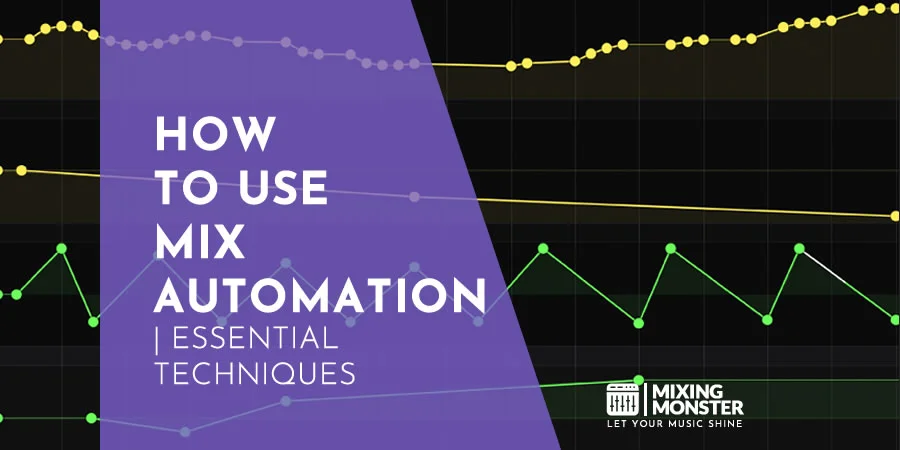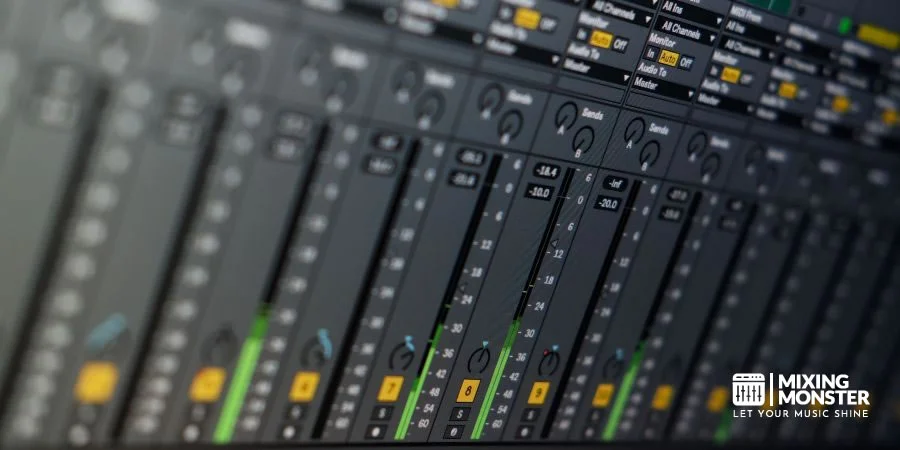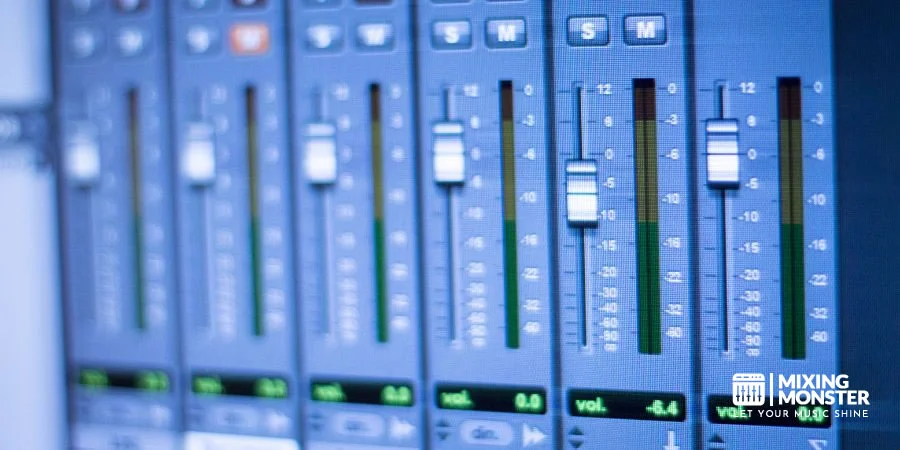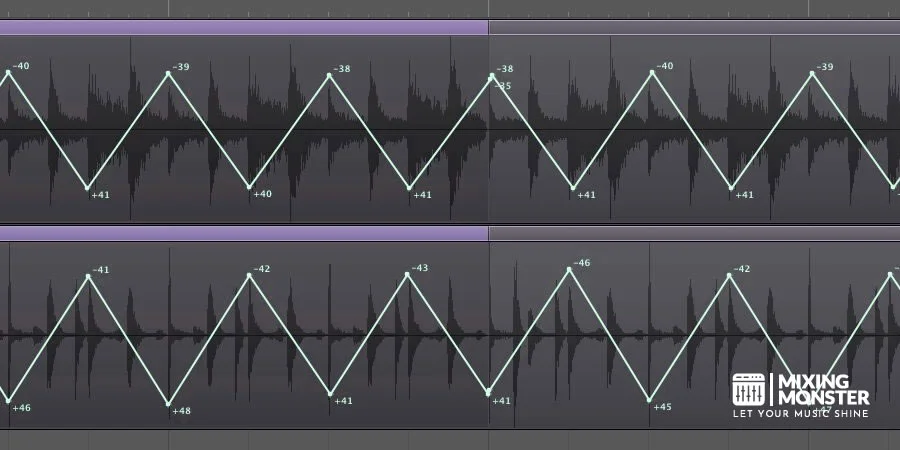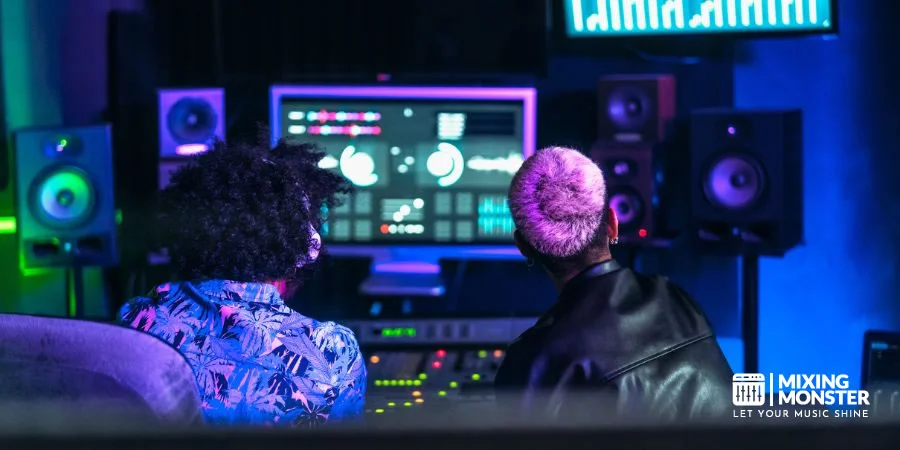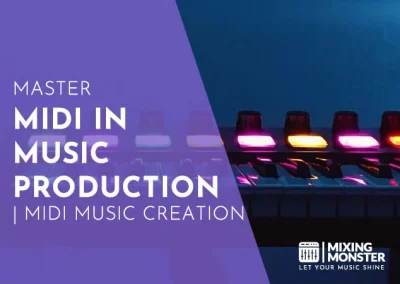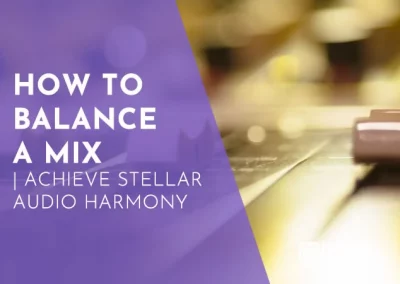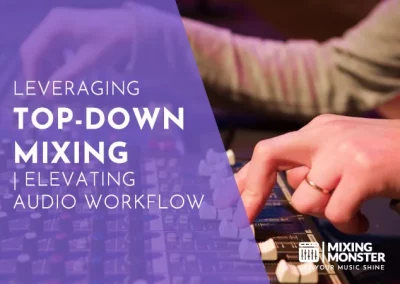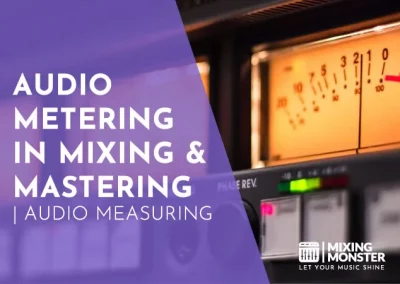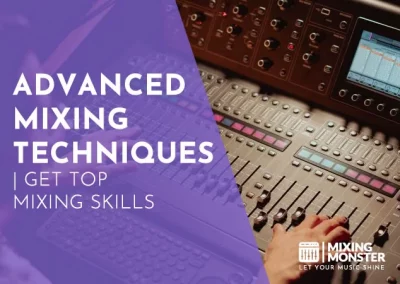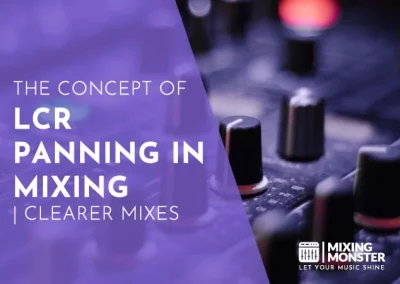Home > Blog > Mixing > Mixing Techniques
Affiliate Disclaimer: We may earn a commission if you purchase through our links
Mix automation is pivotal in modern audio production, offering unparalleled control and precision. Sound engineers and producers can transform ordinary tracks into dynamic masterpieces by understanding and applying mix automation techniques. This intricate process enhances the audio quality and breathes life into musical compositions, making mix automation an indispensable tool in the industry.
Mix automation is a technique in contemporary audio engineering that offers unmatched precision and dynamic control in music production. By manipulating various elements like volume, panning, and effects, mix automation allows for intricate adjustments that elevate the listening experience. Its impact on a track’s overall sound quality and artistic expression is profound.
Continue reading to uncover the secrets of mix automation and learn how to harness its full potential to revolutionize your audio projects.
Table Of Contents
1. Understanding The Basics Of Mix Automation
2. Setting Up For Mix Automation
3. Mastering Volume Automation In A Mix
4. Advanced Mix Automation Techniques
5. Common Automation Challenges And Solutions
6. Automation Tips From Industry Professionals
7. Mix Automation – An Essential Technique For Better Mixes
8. FAQ

1. Understanding The Basics Of Mix Automation
What Is Mix Automation In Audio Production?
Mix automation is a transformative process in audio production that allows sound engineers and producers to alter various track elements over time. It involves programming changes in parameters like volume, panning, and effects throughout a song or piece of audio.
This technique is not just about making adjustments; it’s about enhancing the emotional impact and clarity of the audio. Mix automation provides a way to meticulously craft a sonic journey, ensuring each track part is heard precisely as intended at the precise moment.
The Role Of Automation In Audio Engineering
Automation is a crucial tool for achieving a polished and professional sound in audio engineering. It offers the ability to make precise, repeatable adjustments essential for balancing complex mixes.
Whether subtly adjusting the level of a vocal track during a chorus or adding a sweeping effect to a guitar solo, automation empowers engineers with the flexibility to make these changes consistently across multiple playback sessions.
By enabling detailed control over every aspect of a mix, automation has become an indispensable part of modern audio production, elevating the quality and expressiveness of music.
2. Setting Up For Mix Automation
Which Elements Can Be Automated In A Mix?
In audio mixing, virtually any parameter can be subject to automation. The most common elements include volume, panning, and effects parameters like reverb size, delay feedback, or filter cutoff.
Even more nuanced aspects, such as the parameters of a synthesizer or the settings of a dynamic processor (like a compressor), can be automated. This flexibility allows producers to create more dynamic and engaging soundscapes where mix elements can evolve and interact over time.
Essential Equipment And Software For Mix Automation
To effectively utilize mix automation, you need the right tools. A Digital Audio Workstation (DAW) with automation capabilities is at the core. Most modern DAWs, like Pro Tools, Ableton Live, and Logic Pro, offer comprehensive automation features.
In addition to a DAW, having a control surface can significantly enhance the ease and intuitiveness of automation. These surfaces provide physical faders and knobs for a more tactile mixing experience, allowing for more natural and fluid adjustments than a mouse and keyboard alone.
Equipment And Software For Mix Automation
-
- Digital Audio Workstation (DAW) with automation capabilities (e.g., Pro Tools, Ableton Live, Logic Pro)
- Control surface with motorized faders for tactile control (e.g., Behringer X-Touch, Presonus FaderPort)
- High-quality studio monitors for accurate audio reproduction
- A reliable computer with sufficient processing power and memory
- High-resolution audio interface for clear sound input and output
- Quality headphones for detailed listening and mixing
- Plugins with automation compatibility for effects and processing
Preparing Your Audio Tracks For Mix Automation
Preparation is critical to a successful automation process. Begin by organizing your tracks and ensuring each mix element is clearly labeled and easily accessible.
Apply basic level-setting and panning to establish a rough mix before diving into detailed automation. Segmenting your track into different sections (verse, chorus, bridge, etc.) is also beneficial to approach automation more methodically.
When you start automating your mix, this initial setup helps create a more structured and efficient workflow.

3. Mastering Volume Automation In A Mix
Why Automating The Volume Of Your Mix?
Volume automation is crucial in audio mixing for several reasons. It allows for precise control over the dynamics of each track, ensuring that every element is heard clearly at the right moments.
This is especially important in complex mixes where multiple instruments and vocals compete for space. Volume automation also helps emphasize a song’s emotional highs and lows, allowing for a more impactful and expressive sound.
Mixers can guide the listener’s attention and enhance the overall musical experience by carefully sculpting the volume levels throughout a track.
Techniques For Effective Volume Control Automation
Effective volume automation requires both technical skill and artistic sensibility. Start by identifying key moments in the track where changes in volume can enhance the musical narrative.
Gradual fades, sudden drops, and subtle level adjustments can all contribute to the track’s emotional impact. It’s essential to listen critically and make adjustments in the context of the entire mix rather than focusing on individual tracks in isolation.
Automation should be smooth and purposeful, avoiding abrupt changes that can distract the listener.
Best Practices For Volume Automation
A few best practices can significantly improve the effectiveness of volume automation.
First, use automation sparingly and purposefully; over-automation can lead to an unnatural mix. Making broad, gentle adjustments rather than numerous small changes is often more effective.
Secondly, consider the overall dynamic range of your track – automation should enhance, not compress, this range.
Lastly, always revisit and refine your automation moves after a break to ensure they contribute positively to the mix.
Things To Avoid When Applying Volume Automation
When applying volume automation, keep the process simple. Excessive adjustments can make the mix feel disjointed and disrupt the flow of the music.
Also, be cautious of automating too early in the mixing process; having a solid static mix as a foundation is vital.
Lastly, avoid relying solely on visual cues; trust your ears more than your eyes to judge the effectiveness of your automation.

4. Advanced Mix Automation Techniques
Automating Different Elements In A Mix
Beyond volume, other mix elements like EQ settings, effects parameters, and panning can also be automated to create a dynamic soundscape.
Automating EQ can help bring out specific frequencies at certain moments, such as enhancing the brightness of a guitar during a solo. Effects like reverb or delay can be automated to vary their intensity or character, adding depth and texture to the mix.
Automating Panning
Panning automation, moving sounds across the stereo field, can create a sense of movement and space, providing a more immersive listening experience.
It is a powerful tool for creating a spatially engaging mix and allows for the movement of sound sources within the stereo field, which can be used creatively to draw the listener’s attention or to mimic the action in a live performance.
Effective panning automation should be smooth and logical, enhancing the narrative of the music without being distracting. When automating panning, it’s essential to consider the balance and interaction of all elements in the mix.
Automating Effects
Automating effect parameters can transform a static effect into a dynamic and expressive part of the mix.
For instance, automating the depth or rate of a chorus effect can add life to a guitar part, or automating the decay time of a reverb can create a sense of space that evolves throughout the track.
Maintaining coherence and unity in the mix is vital when automating effects, ensuring that the automated changes complement rather than overpower the original sound.
Creative Uses Of Automation In Mixing
Mix automation also opens up creative possibilities that go beyond traditional mixing techniques.
For example, you can automate filters to create sweeping frequency changes or use automation to create rhythmic variations in effects or volume, adding layers of interest to the track.
These creative uses of automation can add a unique signature to your mix, helping it stand out.

5. Common Automation Challenges And Solutions
Troubleshooting Common Automation Issues
Even experienced mix engineers face challenges when using automation. One common issue is automation clutter, where too many automation points make adjustments challenging to manage and track.
To resolve this, consolidate and simplify automation points, focusing on broader, more impactful changes. Another frequent challenge is automation timing, particularly syncing dynamic changes with the musical rhythm.
To address this, use grid-snapping when appropriate and always rely on your ears to fine-tune the timing.
Common Automation Challenges And Solutions
| Challenge | Description | Solution |
| Automation Clutter | Too many automation points make adjustments difficult. | Consolidate and simplify automation points; focus on broader changes. |
| Timing Issues | Difficulty syncing automation changes with the musical rhythm. | Use grid-snapping and rely on ears for fine-tuning. |
| Over-automation | Making too many unnecessary adjustments. | Use automation sparingly and purposefully; avoid overcomplicating. |
| Premature Automation | Automating before establishing a solid static mix. | Focus on creating a solid foundational mix before applying automation. |
| Visual Dependency | Relying on visual cues rather than auditory feedback. | Trust your ears more than your eyes; listen critically to the changes. |
Bus Automation Vs. Automating Individual Tracks
A critical decision in mix automation is whether to automate individual tracks or entire buses. Bus automation can be a powerful tool for grouping similar instruments and applying cohesive changes, like gradually increasing intensity for all background vocals.
However, individual track automation offers more precise control, allowing for detailed adjustments to each element. The choice depends on the desired outcome and the complexity of the mix.
Often, a combination of both techniques yields the best results.
Tips For Smooth Automation Workflow
To ensure a smooth automation process:
- Start with a clear plan of what you aim to achieve with automation.
- Make initial adjustments in broad strokes, then refine the details.
- Save frequently and consider using versioning to keep track of different automation stages.
It’s also beneficial to periodically bypass all automation to compare against the original mix, ensuring that your adjustments enhance, not detract from, the overall sound.
Lastly, take breaks to rest your ears and return with a fresh perspective.
6. Automation Tips From Industry Professionals
Expert Insights On Mix Automation
Gaining insights from industry professionals can significantly enhance your understanding and application of mix automation.
Many seasoned engineers emphasize the importance of using automation to serve the song, not just as a technical showcase. They often suggest starting with subtle changes and gradually increasing the complexity of automation moves as needed.
Another standard advice is to automate in the context of the final listening environment, considering how the changes will sound in different spaces and on various playback systems.
Keeping Up With Industry Trends In Mix Automation
The field of audio production is constantly evolving, as are the techniques and tools for mix automation.
Staying informed about the latest trends is helpful. For instance, integrating AI and machine learning in some modern DAWs is starting to influence how automation can be applied more efficiently and creatively.
Additionally, immersive audio formats like Dolby Atmos are pushing the boundaries of spatial automation in mixing. Keeping abreast of these developments ensures that your skills remain relevant and your mixes sound current.

7. Mix Automation – An Essential Technique For Better Mixes
Key Takeaways When Applying Mix Automation
Mix automation is not just a technical skill; it’s an art that enhances a mix’s emotional impact and clarity. The key takeaway for anyone diving into mix automation is the importance of intentionality.
Every automated move should have a purpose: highlight a pivotal moment in the track, create dynamic interest, or balance the elements within a mix.
Also, remember that automation should always enhance the song’s narrative and emotion, not overshadow it.
Automate Your Mix: Start Applying Automation In Every Mix
Encouraging the regular use of automation in your mixing process can significantly improve the quality of your productions.
Start by integrating simple automation tasks in your workflow, such as volume adjustments for chorus and verse transitions or panning movements for stereo interest. As you become more comfortable, you can explore more complex automation techniques.
The practice of consistently applying automation will not only improve the quality of your mixes but also develop your skills as a versatile audio engineer.
Happy automating!

8. FAQ
- How Does Mix Automation Impact The Final Sound?
Mix automation significantly impacts the final sound by providing precise control over the dynamic changes within a track. It allows for nuanced adjustments that can bring balance, enhance emotional impact, and ensure clarity in the mix. Automation helps highlight key elements at the right moments and maintain interest throughout the track. - Can Beginners Easily Learn Mix Automation?
Yes, beginners can learn to mix automation, especially with the user-friendly interfaces of modern Digital Audio Workstations. Starting with essential volume and panning automation is an excellent way to get comfortable with the concepts before moving on to more complex techniques. Numerous online tutorials and resources are also available to help beginners get started. - What Are Some Common Mistakes In Mix Automation?
Common mistakes in mix automation include over-automating, which can make a mix sound unnatural or overly busy, and neglecting the context of the entire mix when making adjustments. Another mistake is relying too heavily on visual cues rather than trusting one’s ears. - Which Elements In A Mix Should Be Automated?
Elements commonly automated in a mix include volume, panning, EQ settings, and effects parameters. The choice of what to automate should be guided by the track’s needs and the mix’s creative vision. - Is It Necessary To Apply Automation In Audio Mixing?
While not always necessary, automation is a highly beneficial tool in audio mixing. It adds dynamic interest and can solve mix issues that static adjustments cannot address. Automation is essential in complex mixes or when striving for high polish and professionalism.

